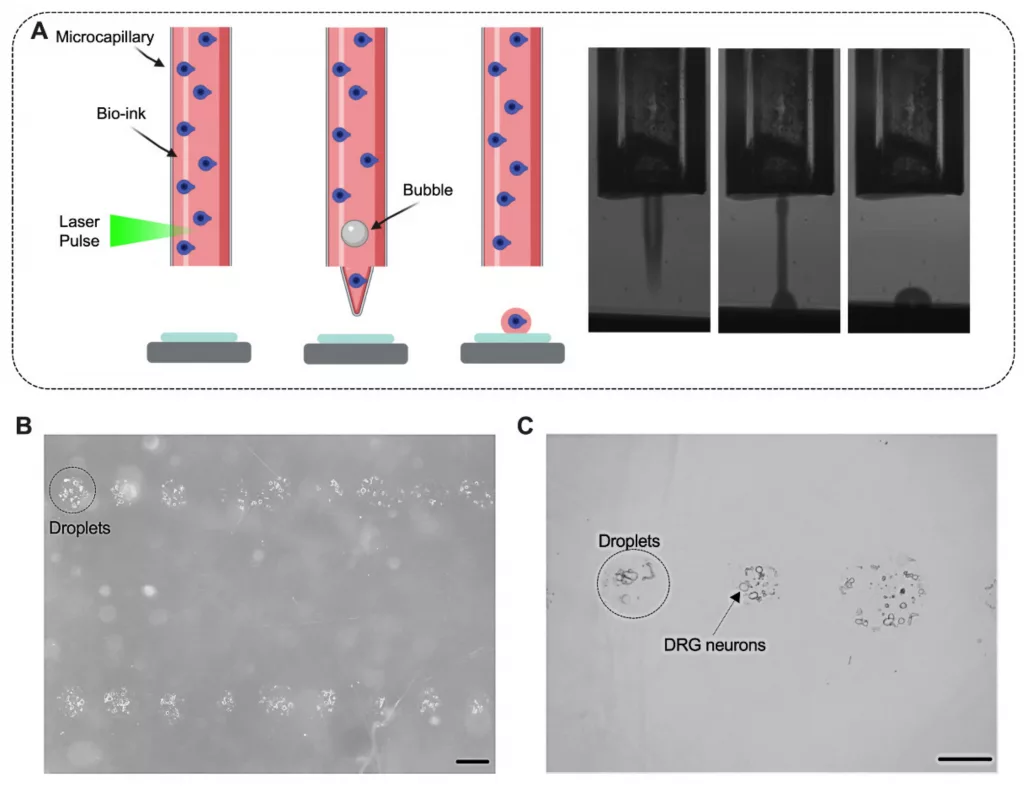Scientists from the Université de Montréal have published a study detailing the ability to bioprint adult brain cells. Key to the research was a new laser-assisted technology that made it possible to ensure high levels of cell viability and functionality.
The team calls the process “Laser-Induced Side Transfer (LIST)”, previously covered on 3DPrint.com here, and it has advantages over some other bioprinting techniques through its ability to print with materials of different viscosities. To demonstrate the potential of the technique in neurology, the researchers 3D printed sensory neurons, key to the peripheral nervous system and the ability to process sense stimuli.
 “Laser-induced side transfer (LIST) of neurons. Schematic representation of the printing system (A left) and indicative high-speed imaging of bioink ejection (A right). Printed droplets with DRG neurons 1 h after printing. (B,C). Scale bar = 50 µM (B,C).” Image courtesy of micromachines.
“Laser-induced side transfer (LIST) of neurons. Schematic representation of the printing system (A left) and indicative high-speed imaging of bioink ejection (A right). Printed droplets with DRG neurons 1 h after printing. (B,C). Scale bar = 50 µM (B,C).” Image courtesy of micromachines.The researchers suspended dorsal root ganglion (DRG) neurons, extracted from the peripheral nervous system of mice, within a bioink solution. This was loaded into a square capillary atop a biocompatible substrate before low-energy nanosecond lasers were pulsed as the middle fo the capillary. This resulted in the formation of microbubbles that, when expanding, ejected cells onto the below substrate. Next, the samples were incubated, washed, and then incubated once more for 48 hours.
Running a viability assay, the team determined that 86 percent of the cells were still viable two days after printing. These results were further improved when the lasers used lower amounts of energy, as higher power levels damaged the cells. Other tests were encouraging as well. These included calcium imaging, RNA sequencing, neuropeptide release, and measuring the ability to form new projections in response to environmental cues (neurite outgrowth).
 “Bioprinting does not impact DRG neurons’ survival, but reduces neurite outgrowth. Representative fluorescence images of adult VGlut2cre::td-tomatofl/wt DRG neurons mice printed with low (100 µJ, E–H) or high energy (120 µJ, I–L) or put in cell culture (control, A–D). Percentage of viable cells 2 days post-printing (M; determined as fixable Viability Dye eFluor™ 780-) and average neurite length (N, in µm). Results consist of the means ± S.E.M. One-way ANOVA with Tukey’s multi comparisons test. Significant differences in M and N are indicated by asterisks (p < 0.05 = *; p < 0.01 = **; p < 0.0001 = ****). Nucleus (Blue; A,E,I), VGlut2cre::td-tomatofl/wt neurons (red; B,F,J), dead cells (purple; C,G,K). Scale bar = 50 µM (A–L).” Image courtesy of micromachines.
“Bioprinting does not impact DRG neurons’ survival, but reduces neurite outgrowth. Representative fluorescence images of adult VGlut2cre::td-tomatofl/wt DRG neurons mice printed with low (100 µJ, E–H) or high energy (120 µJ, I–L) or put in cell culture (control, A–D). Percentage of viable cells 2 days post-printing (M; determined as fixable Viability Dye eFluor™ 780-) and average neurite length (N, in µm). Results consist of the means ± S.E.M. One-way ANOVA with Tukey’s multi comparisons test. Significant differences in M and N are indicated by asterisks (p < 0.05 = *; p < 0.01 = **; p < 0.0001 = ****). Nucleus (Blue; A,E,I), VGlut2cre::td-tomatofl/wt neurons (red; B,F,J), dead cells (purple; C,G,K). Scale bar = 50 µM (A–L).” Image courtesy of micromachines.It’s worth noting that this is not the first bioprinting method that involves the use of lasers, nor the first 3D printed adult braincells. Poietis, for instance, is known for its laser-assisted bioprinting technique, which relies on laser pulses to deposit cell-laden bioinks onto an ink film spread on a glass plate. Researchers in China were able to maintain bioprinted neuron viability for an impressive four weeks. Fluicell has bioprinted neural cells in the past. A University of Minnesota team was able to 3D print neurons to create a bioficial spinal cord.
The study suggests a number of possible applications, such as drug testing, disease modeling, and 3D printing implants. Most immediately, the team is considering the use of this technology for developing new medications.
Subscribe to Our Email Newsletter
Stay up-to-date on all the latest news from the 3D printing industry and receive information and offers from third party vendors.
You May Also Like
3D Printing Unpeeled: New Arkema Material for HP, Saddle and Macro MEMS
A new Arkema material for MJF is said to reduce costs per part by up to 25% and have an 85% reusability ratio. HP 3D HR PA 12 S has been...
3D Printing News Briefs, January 20, 2024: FDM, LPBF, Underwater 3D Printer, Racing, & More
We’re starting off with a process certification in today’s 3D Printing News Briefs, and then moving on to research about solute trapping, laser powder bed fusion, and then moving on...
3D Printing Webinar and Event Roundup: December 3, 2023
We’ve got plenty of events and webinars coming up for you this week! Quickparts is having a Manufacturing Roadshow, America Makes is holding a Member Town Hall, Stratafest makes two...
Formnext 2023 Day Three: Slam Dunk
I’m high—high on trade show. I’ve met numerous new faces and reconnected with old friends, creating an absolutely wonderful atmosphere. The excitement is palpable over several emerging developments. The high...































